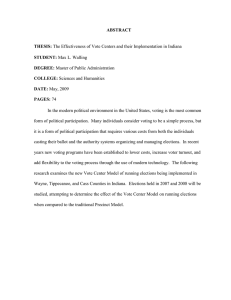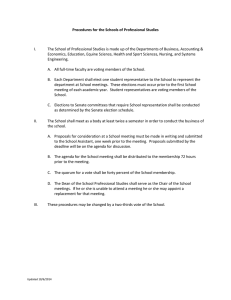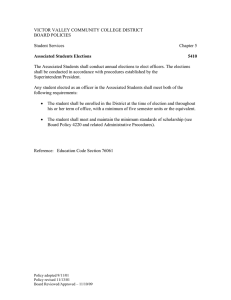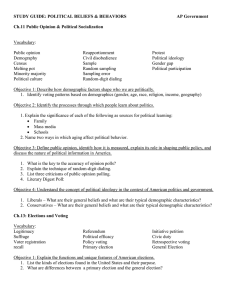Learning Objectives After studying Chapter 10, you should be able to:
advertisement
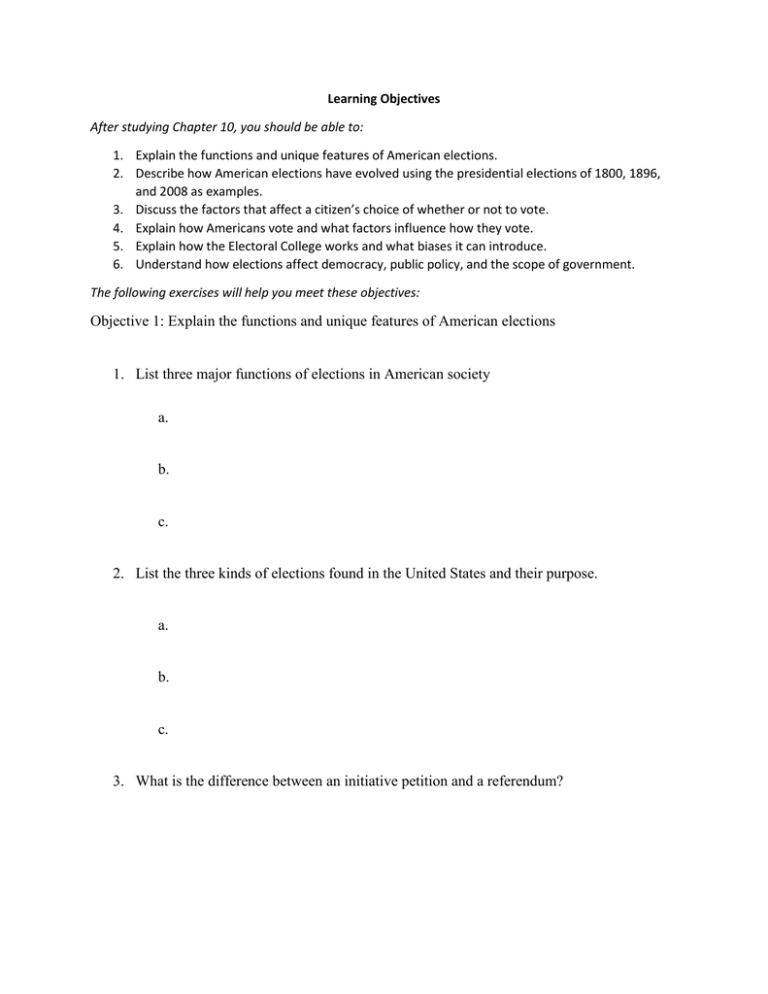
Learning Objectives After studying Chapter 10, you should be able to: 1. Explain the functions and unique features of American elections. 2. Describe how American elections have evolved using the presidential elections of 1800, 1896, and 2008 as examples. 3. Discuss the factors that affect a citizen’s choice of whether or not to vote. 4. Explain how Americans vote and what factors influence how they vote. 5. Explain how the Electoral College works and what biases it can introduce. 6. Understand how elections affect democracy, public policy, and the scope of government. The following exercises will help you meet these objectives: Objective 1: Explain the functions and unique features of American elections 1. List three major functions of elections in American society a. b. c. 2. List the three kinds of elections found in the United States and their purpose. a. b. c. 3. What is the difference between an initiative petition and a referendum? Objective 2: Describe how American elections have evolved using the presidential elections of 1800, 1896, 2008. 1. Complete the following table: Year Candidates Winner and Party Major Issues Campaign Significance Style of Election 1800 1896 2008 2. What were the major reasons why people voted for either Barack Obama or John McCain in the 2008 presidential election? a. Barack Obama: b. John McCain: Objective 3: Discuss the factors that affect a citizen’s choice of whether or not to vote. 1. List and explain three major reasons why people might vote. a. b. c. 2. What are the major provisions of the 1993 Motor Voter Act? 3. List and explain six demographic factors that are related to voter turnout. a. b. c. d. e. f. Objective 4: Explain how Americans vote and what factors influence how they vote. 1. What is meant by the “mandate theory of elections”? 2. How has the influence of party identification on voting changed since the 1950’s? 3. What are the three most important dimensions of candidate image? a. b. c. 4. What are the four conditions necessary for true policy voting to take place? a. b. c. d. Objective 5: Explain how the Electoral College works and what biases it can introduce. 1. Briefly explain how the Electoral College works. 2. What are the two reasons why the Electoral College is important to presidential elections? a. b. Objective 6: Understand how elections affect democracy, public policy, and the scope of government. 1. What are the two tasks that elections accomplish, according to democratic theory? a. b. 2. According to the text, what is the clearest way in which elections broadly affect public policy? 3. What is retrospective voting? Key Terms Identify and describe: Legitimacy Referendum Initiative petition Suffrage Political efficacy Civic duty Voter registration Motor Voter Act Mandate theory of elections Policy voting Electoral College Retrospective voting Compare and contrast: Initiative petition and referendum Suffrage and voter registration Voter registration and Motor Voter Act Policy differences and civic duty Mandate theory of elections and policy voting
